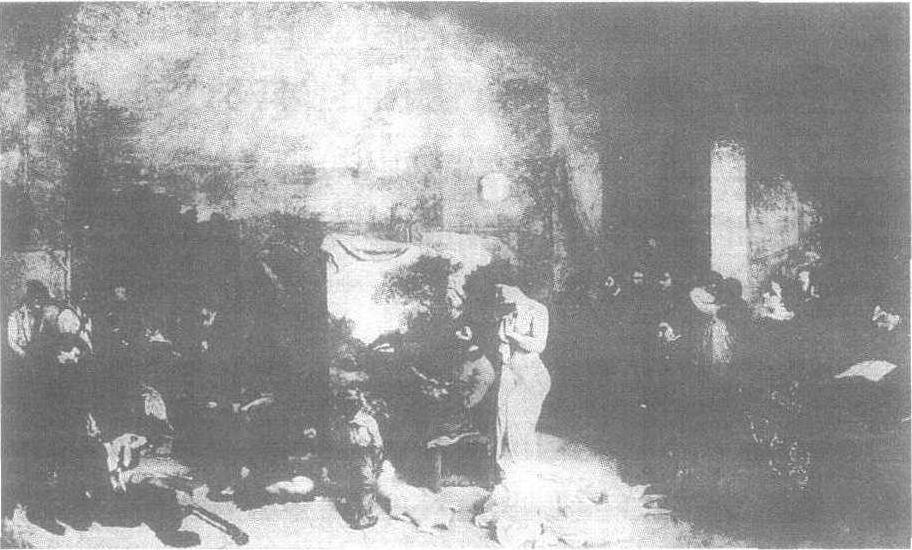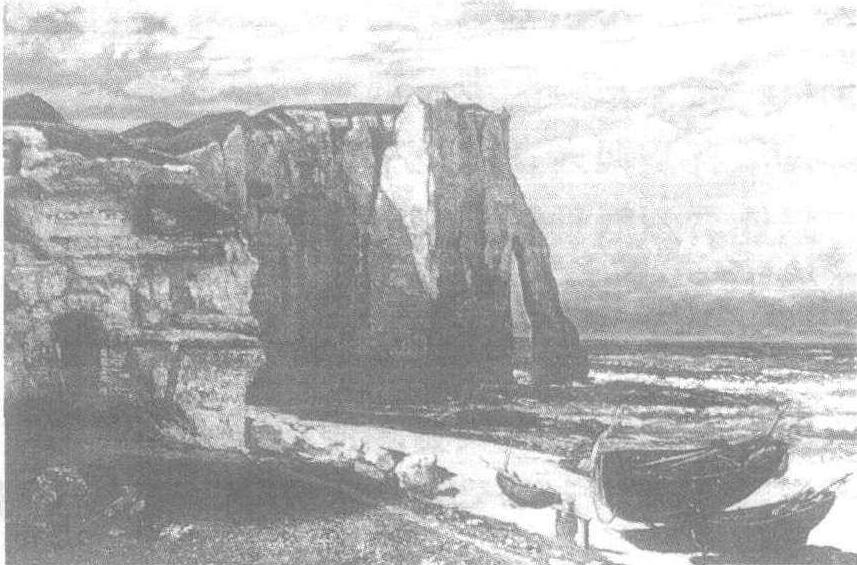库尔贝《画室》
我们走上卢佛尔美术馆西侧的楼梯,从充满午后阳光的入口处看去,一幅有着温暖色调的大画——库尔贝的《画室》,就在眼前。
这幅画,比起我们所看到的其他伟大作品来,更像是一场梦。画里描绘的无疑是库尔贝自己的画室。然而画室中为什么聚集了这么多人?他们好像由魔术师呼唤出来的一样。他们在那里互相保持缄默和孤立地呆着,并渐渐消失在背景的布景之中。而这间画室的景深,很像一座景物不断变换的舞台。

画室 库尔贝
然而“解铃还待系铃人”。库尔贝自己把这幅既有着强烈的现实感,又充满象征意义的画赋予了一个非常恰当而又很长的题名: “现实的寓意,在某个方面决定了我七年艺术生涯的画室的内部”。
回答就是这么简单。在画面中央,坐着自称是写实主义者的库尔贝,他正在画着他所出生的故乡佛朗修 ·孔德的风景。在他身后站着女裸体模特。他认为这两者是支持他纯真的艺术的基础。还有 一个天真的村童,怀着敬意在看他作画。不难看出,比起美术学院里那些大人物们的批评来,这小孩子的评价更是库尔贝所希望的。
我们继续往下看,在画面右手,是一群曾经影响过库尔贝的人。他们中有倾向于他的文艺评论家商弗勒里,他坐在远处欣赏着库尔贝的创作。最右边埋头看书的是诗人、文艺批评家波特莱尔。画面深处,脸胖胖的是库尔贝的友人、哲学家普鲁东。还有保护人兼收藏家布留亚斯等。前景上站着一对夫妇,他们穿着高贵的服装,是所谓 “社交场上的美术爱好者”。
画面左手,在画架旁边圣塞巴斯蒂安的石膏像下,一个衣衫蓝缕的妇女正在给孩子喂奶,反映了社会贫富悬殊的悲惨现实。画面纵深处有掘墓人、娼妓、小商贩、农民、失业者等等,他们代表着社会底层的生活。最左端的犹太教博士和天主教神父,以及前面牵着狗的猎人,他们象征着社会意识。
总之,库尔贝在这幅作品中,试图表现出当时整个法国社会的缩影。
库尔贝(1819—1877)是从北方农村来到巴黎的画家。他生性是个叛逆者,曾因参加巴黎公社而入狱,差点被处死。1848年,他画过一幅“采石工人”,原意只是忠实地记录 一个老邻居的生活。但他的朋友看过后说它是那些工人的第一块伟大里程碑云云。库尔贝被这种说法搞得心头大乐。随后 一年,他借着一幅表现家乡葬礼的巨画《奥南的葬礼》,把他对一般人的同情发挥得更加淋漓尽致,令人看后大受感动。他放弃通常的绘画手法,以避免形成从属关系,让他的人物不分主角配角站成一排,以表达人在死神面前都是平等的思想。在《画室》 中,同样反映了他复杂的生活体验,更可以看到普鲁东社会主义思想对他的影响。

海边断崖 库尔贝
库尔贝的这些作品,虽说都是叙述当代事实的画,但他作画并非只凭手和眼的感觉。《画室》可以说明显地是一种坚实的理性的产物。我们仅举中间 一组来说明。库尔贝把自己描绘成脸几乎完全是侧面的,并将拿笔的右臂平直伸出。而且把它按接近严格的对等距离,镶入与周围复杂地纠缠组合在 一起的正方形之中。其结果,那些在他周围看去像是无法抓住的地方的乱哄哄的人群,因这 一手势而顿时安定下来。不仅如此,他如同浮雕一般的姿态和同样是侧面的女模特结实的肉体,其清晰的轮廓线均显示出 一种超越时间的造型性的感觉。而且他们被椅子和画板边缘部分所看到的薄薄的几何形衬托得愈加醒目。
然而不管怎么说,库尔贝的画由于带有过多的往昔巨匠们的调子和触觉感,作为画家,他在技术上谈不上是 一个叛逆者。他描绘的那些令我们感到愉快的东西——果物、花卉、斑斓的鳟鱼、金发少女、海滨、波涛等小品,反倒要好些。
在卢佛尔美术馆,我们已经看过成为革命初期的宣言的、大卫的《荷加斯兄弟的誓言》,格罗的拿破仑时代的远征图,席里柯的《梅杜萨之筏》,而库尔贝的《画室》,则可以说是法国大革命主旋律的最后 一幕。英雄的时代已经成为过去。当库尔贝用他强有力的手,将那些众多的小人物们从不引人注目的阴暗中唤醒的时候,法国绘画的历史又翻开了新的一页。